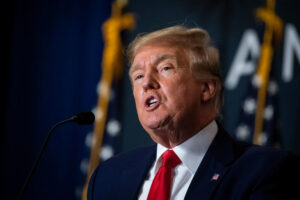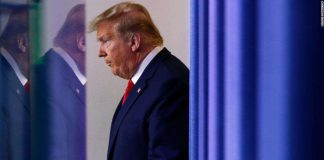AUGUST 12, 2022

Former US President Donald Trump speaks during the America First Policy Institute’s America First Agenda Summit in Washington, D.C., US, on Tuesday, July 26, 2022. Trumps remarks come on the heels of a House hearing that portrayed him standing by indifferently, even vindictively, for hours as a mob of his supporters battled police and chased lawmakers through the halls of the Capitol.
Documents seized from former President Donald Trump’s Mar-a-Lago home bore the US government’s highest top-secret rating, underscoring the sensitive nature of the material he took with him after leaving office.
Court documents unsealed Friday showed that FBI agents seized one box — marked 2A — containing “Various classified/TS/SCI documents. That’s shorthand for “Top Secret/Sensitive Compartmented Information,” the sort of information that the government normally requires to be read only in a protected room by people with high-level security clearances.
Other boxes contained “Miscellaneous Secret Documents,” “Miscellaneous Top Secret Documents,” and “Miscellaneous Confidential Documents,” according to an FBI property receipt included in the court documents. Another item was labeled only “info re: President of France.”
“This could be information about intercepted communications,” John Bellinger, a partner at Arnold & Porter who was legal adviser to the National Security Council under President George W. Bush, said in an interview with David Westin on Bloomberg Radio. “That’s very, very tightly controlled. If Trump took some of that off with him to Mar-a-Lago, he could declassify it, but it would certainly look bad if he tried to do it.”
One of the mysteries of the Federal Bureau of Investigation’s move so far is that Trump has argued he was cooperating, and that the search was a surprise. Earlier Friday, he issued a statement saying the information had been declassified.
“Number one, it was all declassified,” Trump said. “Number two, they didn’t need to ‘seize’ anything. They could have had it anytime they wanted without playing politics and breaking into Mar-a-Lago. It was in secured storage, with an additional lock put on as per their request.”
The court documents released on Friday didn’t give any detail about the nature of the top-secret information. On Thursday, the Washington Post cited people familiar with the matter as saying some of the seized items were classified documents related to nuclear weapons.
The FBI’s search of Mar-a-Lago appeared to be the culmination of an 18-month effort by the National Archives and Records Administration to retrieve presidential records that were taken to the Florida resort.
Staff members at NARA first learned earlier this year that presidential records removed from the White House and stored at the former president’s Palm Beach resort contained “classified national security information,” according to a February letter from national archivist David Ferriero. He wrote it in response to questions from US Representative Carolyn Maloney, the Democrat who chairs the House Committee on Oversight and Reform.
NARA “had ongoing communications” with Trump’s representatives “throughout 2021, which resulted in the transfer of 15 boxes to NARA in January 2022.”
It was only after archivists began indexing those recovered records that they discovered the boxes contained “classified national security information,” Ferriero wrote in his Feb. 18th letter to Maloney, which prompted NARA staff to contact the Justice Department and resulted in the investigation that led to the FBI’s search on Monday.
Ferriero was referring to presidential Executive Order 13526, which sets out the systems for safeguarding national security information. The order, signed by Obama in 2009 and left unchanged by Trump, says classified information “may not be removed from official premises without proper authorization.”
In some cases, Trump may have had the authority to declassify the documents. But even a US president doesn’t have the authority to declassify some information, such as those marked “restricted data” under the Atomic Energy Act. There was no indication any of the documents seized from Mar-a-Lago bore that classification.
“Disclosure of it would have a serious adverse impact on the national security,” Neil Eggleston, former White House counsel under President Barack Obama, said of the documents. “I can’t imagine why Trump would have this material. I just can’t imagine.”
“It’s just hard to know why this whole battle ensued and why President Trump didn’t simply return it when he was asked for it,” Eggleston said. “Presumably he would’ve said at the time we took this, we took it inadvertently.”










































































































